Overclockable Pentium Anniversary Edition Review: The Intel Pentium G3258
by Ian Cutress on July 14, 2014 10:00 AM EST- Posted in
- CPUs
- Intel
- Pentium
- Overclocking
- Pentium-AE
- G3258
CPU Benchmarks
The dynamics of CPU Turbo modes, both Intel and AMD, can cause concern during environments with a variable threaded workload. There is also an added issue of the motherboard remaining consistent, depending on how the motherboard manufacturer wants to add in their own boosting technologies over the ones that Intel would prefer they used. In order to remain consistent, we implement an OS-level unique high performance mode on all the CPUs we test which should override any motherboard manufacturer performance mode.
HandBrake, SD Film: link
For HandBrake, we take two videos (a 2h20 640x266 DVD rip and a 10min double UHD 3840x4320 animation short) and convert them to x264 format in an MP4 container. Results are given in terms of the frames per second processed, and HandBrake uses as many threads as possible.
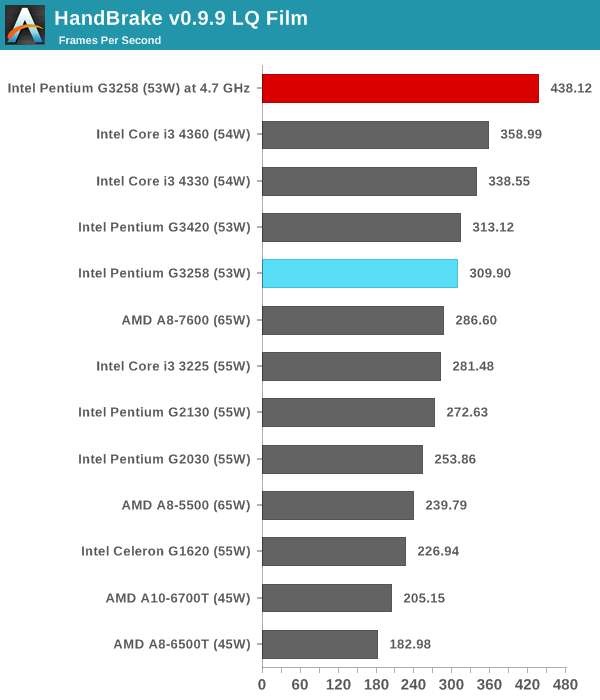
For low quality encoding, single threaded performance wins out over threads despite the extra multi-threading of i3 processors.
HandBrake, 4K60 Animation: link

For larger frame sizes, the extra MHz of the overclock brings it on par with the i3-4360, although one might suggest spending the extra $40 for the i3 to ensure full stability.
Agisoft Photoscan – 2D to 3D Image Manipulation: link
Agisoft Photoscan creates 3D models from 2D images, a process which is very computationally expensive. The algorithm is split into four distinct phases, and different phases of the model reconstruction require either fast memory, fast IPC, more cores, or even OpenCL compute devices to hand. Agisoft supplied us with a special version of the software to script the process, where we take 50 images of a stately home and convert it into a medium quality model. This benchmark typically takes around 15-20 minutes on a high end PC on the CPU alone, with GPUs reducing the time.
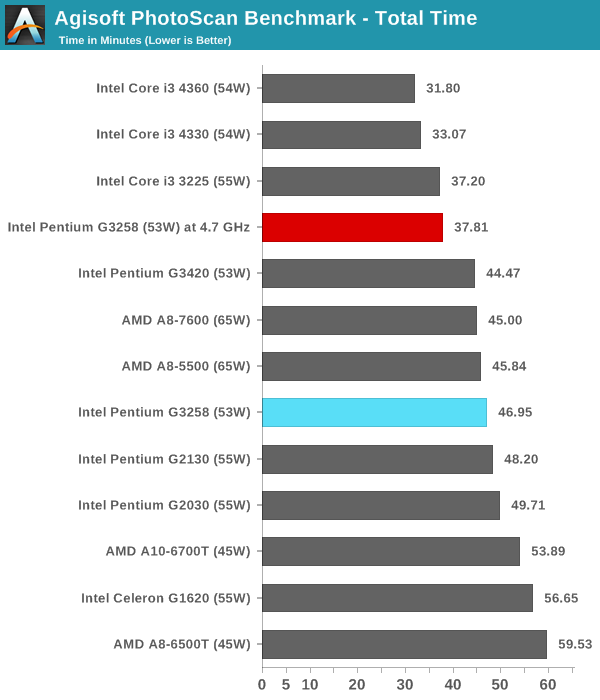
Dolphin Benchmark: link
Many emulators are often bound by single thread CPU performance, and general reports tended to suggest that Haswell provided a significant boost to emulator performance. This benchmark runs a Wii program that raytraces a complex 3D scene inside the Dolphin Wii emulator. Performance on this benchmark is a good proxy of the speed of Dolphin CPU emulation, which is an intensive single core task using most aspects of a CPU. Results are given in minutes, where the Wii itself scores 17.53 minutes.
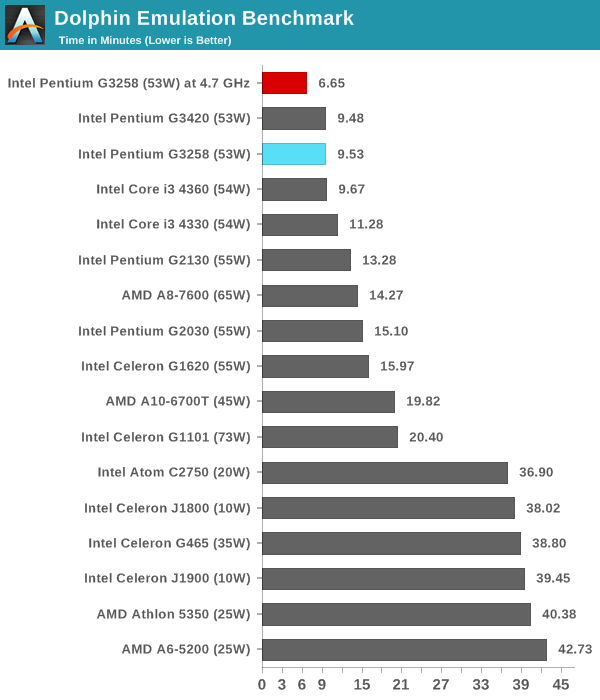
Dolphin is another example where Haswell combined with strong single threaded performance wins.
WinRAR 5.0.1: link
This test compresses a set of 2867 files across 320 folders totaling 1.52 GB in size – 95% of these files are small typical website files, and the rest (90% of the size) are small 30 second 720p videos.
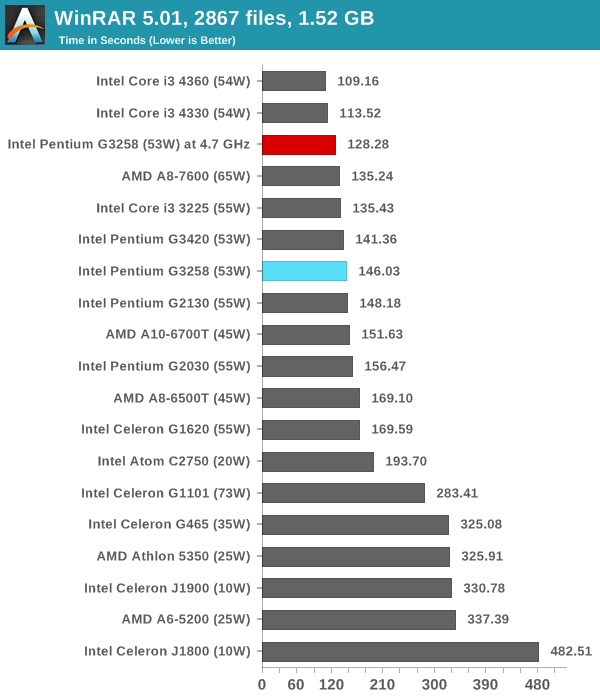
PCMark8 v2 OpenCL on IGP
A new addition to our CPU testing suite is PCMark8 v2, where we test the Work 2.0 and Creative 3.0 suites in OpenCL mode. As this test is new, we have not run it on many AMD systems yet and will do so as soon as we can.
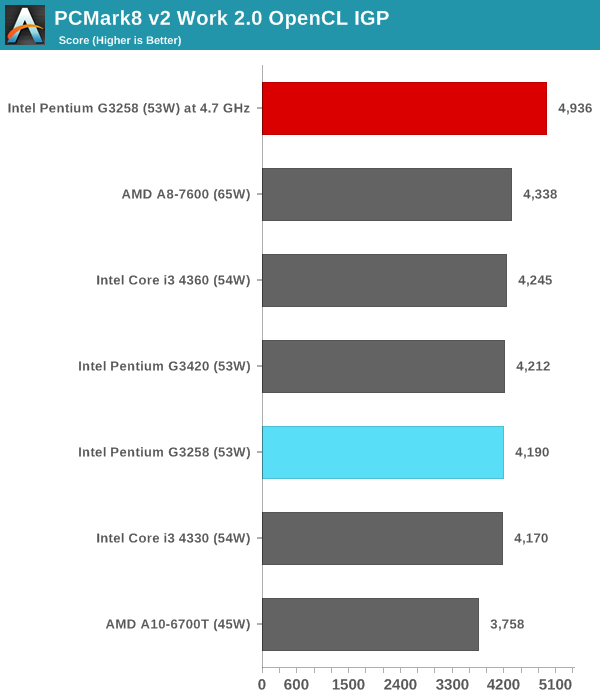
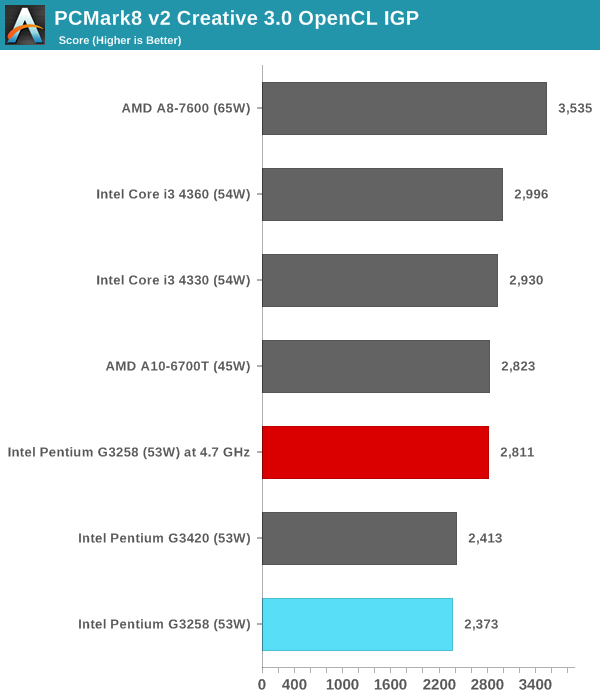
In both of our PCMark8 v2 results, overclocking the CPU gave a significant jump in performance. This would be down to the single threaded nature of parts of the benchmark, allowing web browsing and the snappyness of the system to be sped up.
Hybrid x265
Hybrid is a new benchmark, where we take a 4K 1500 frame video and convert it into an x265 format without audio. Results are given in frames per second.
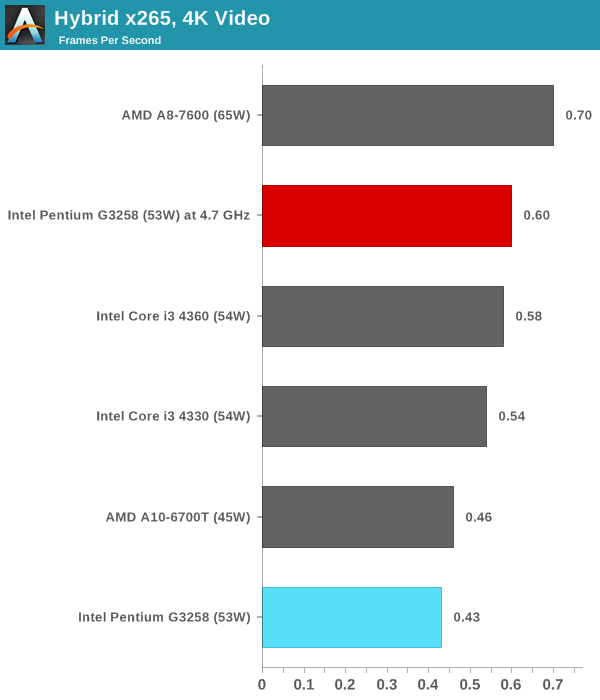
Almost an extra 50% performance for Hybrid x265 encoding.
Cinebench R15
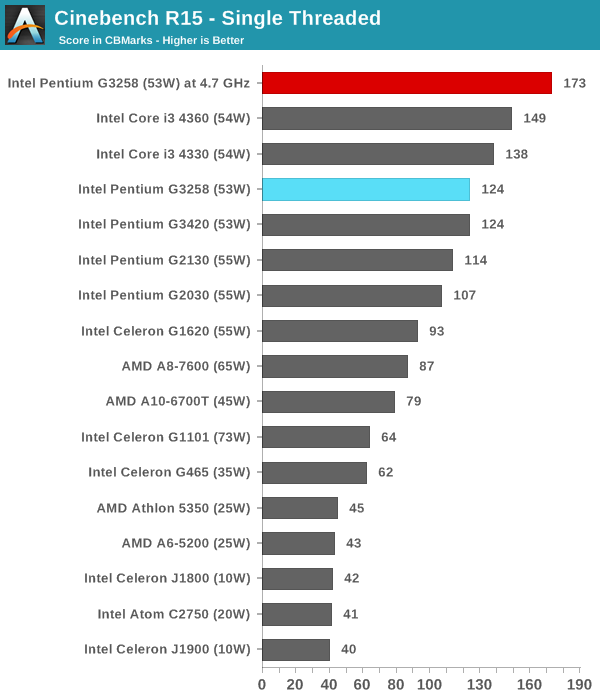
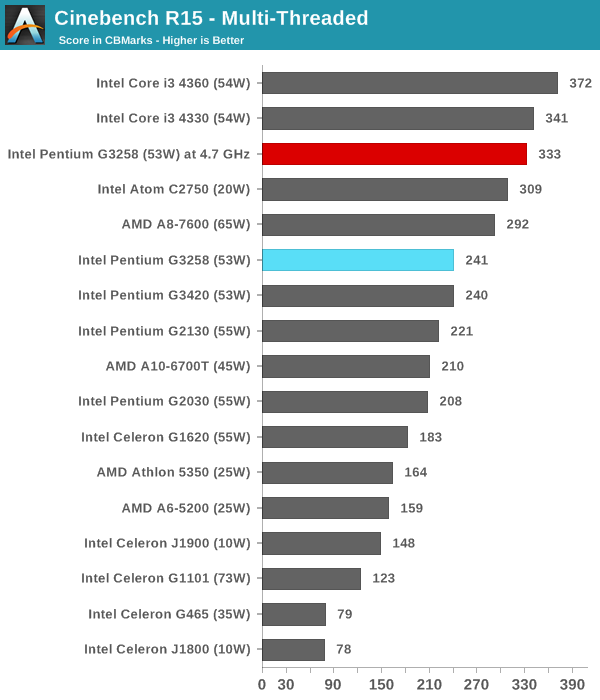
3D Particle Movement
3DPM is a self-penned benchmark, taking basic 3D movement algorithms used in Brownian Motion simulations and testing them for speed. High floating point performance, MHz and IPC wins in the single thread version, whereas the multithread version has to handle the threads and loves more cores.

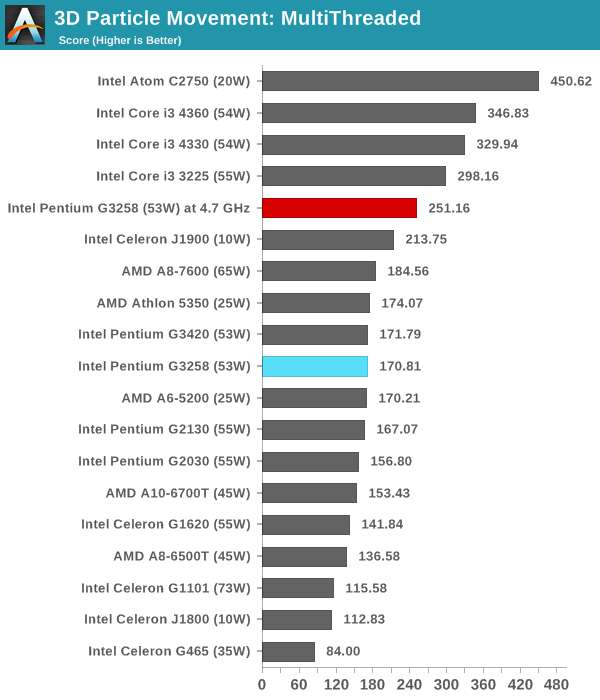
FastStone Image Viewer 4.9
FastStone is the program I use to perform quick or bulk actions on images, such as resizing, adjusting for color and cropping. In our test we take a series of 170 images in various sizes and formats and convert them all into 640x480 .gif files, maintaining the aspect ratio. FastStone does not use multithreading for this test, and results are given in seconds.
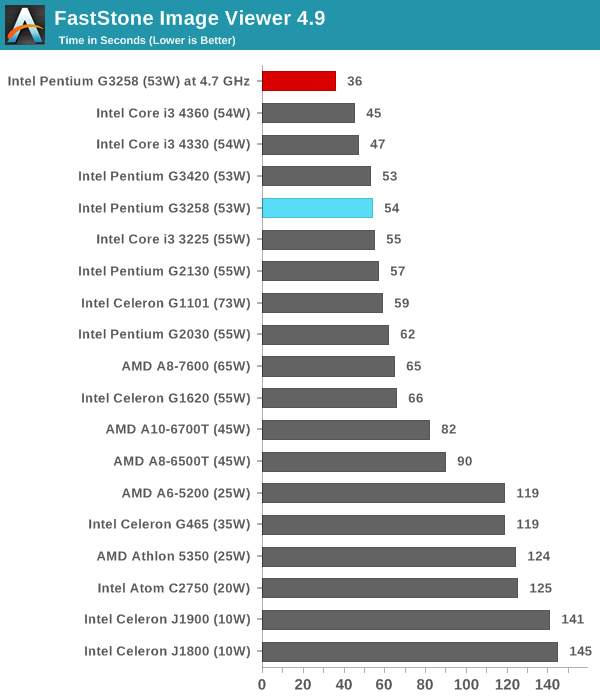
Web Benchmarks
On the lower end processors, general usability is a big factor of experience, especially as we move into the HTML5 era of web browsing. For our web benchmarks, we take four well known tests with Chrome 35 as a consistent browser.
Sunspider 1.0.2

Mozilla Kraken 1.1

WebXPRT
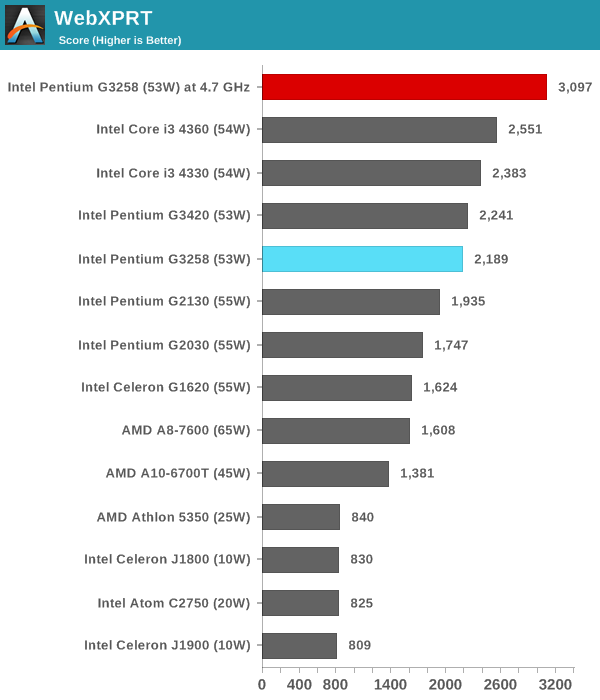
Google Octane v2
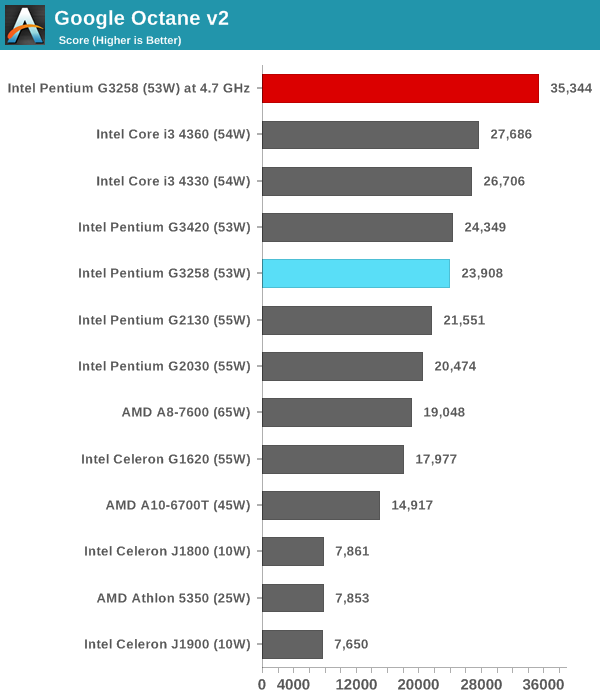
The usage model for an overclocked G3258 comes in highly single threaded environments. 4.7 GHz is nothing to be sniffed at, especially when it comes to web browsing or simple photo editing where it beats out more expensive processors. With multithreaded scenarios, it battles with the i3 depending on if the software can use hyperthreading to its full advantage. If the software can do that, then the i3 still wins out.










96 Comments
View All Comments
mapesdhs - Monday, July 14, 2014 - link
Thanks for the article! An interesting piece, especially the conclusion which is spot on,
but it does need a bit of a proof read, eg. "That is benefit afforded by an overclocking
platform platform...", was particularly painful. ;D
Ian.
monstercameron - Monday, July 14, 2014 - link
cinebench r15 charts seem incorrect.Ian Cutress - Monday, July 14, 2014 - link
Mixed up some of the ST and MT data. Should be fixed now.TheJian - Tuesday, July 15, 2014 - link
So how far do you get on the stock fan? It's good for 95w and this chip is 53w with gpu on, so disabling it using the stock HSF gets you how far? A stock fan built for i7's should get a reasonable overclock with no extra cost (not 4.7ghz obviously). Since this is truly aimed at the poor (who else? people wanting to far around with ocing?), they'll likely be trying it with stock.Any data on that, or did I miss that point in the article? I'd like to know what is stable on stock. Nobody seems to cover this.
techtonic717 - Wednesday, July 16, 2014 - link
I have overclocked one on an Asus H81M motherboard with the stock heatsink. 4.2ghz runs nice. The motherboard ups the voltage to 1.224v and running OCCT it gets temps of up to 64 degrees Celsius at full load. If I go up to 4.4ghz the motherboard ups the voltage to 1.37v and then the temps are in the high 70's to low 80's. Manually lowering the voltage results in crashing. It is still stable but I think 4.2-4.3ghz on the stock cooler is the best option.Zap - Thursday, July 17, 2014 - link
This information is much more useful than the typical "stock HSF sucks" comments. Thanks!EagleEye2014 - Tuesday, August 5, 2014 - link
Hi, could you please provide me the exact motherboard name, i would like to try it at my place and buying a 87 & 97 chip set boards are little costlier to me now, also i have checked the compatible boards for this processor at Intel site and i wasn't able to locate any Asus boards with the 81 chipset, saw a few MSI 81 chipset boards which are not available at my place.smunter6 - Monday, July 14, 2014 - link
Why would you pair this with dual 770's? Of course it's not going to perform as well as an i3, but what about single GPU setups (I saw the results in the first page, but no minimum frame rates??) I can't imagine anyone spending $700+ on GPU's and then reaching this low for the processor, but for a $400 build with a 270 or a 750 Ti? It's a whole different ball game. Please base your review off of realistic use cases!Ian Cutress - Monday, July 14, 2014 - link
Single GPU data is on the first page when you scroll down. We have data for those four CPUs.For direct comparison with other CPUs, our Bench pages use SLI data
smunter6 - Monday, July 14, 2014 - link
Average FPS are listed in this chart, but no minimum frame times like those shown for the dual set ups. Especially when the averages are within 1-2% for most games, I would rather see minimum frame times to highlight the CPU differences rather than the GPU bottleneck.